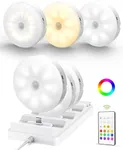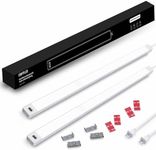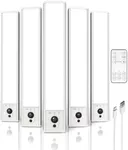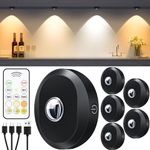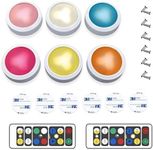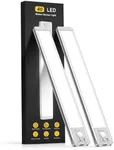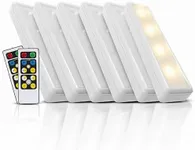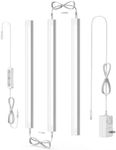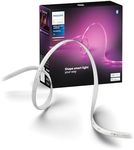Buying Guide for the Best Under Cabinet Lights
Choosing the right under-cabinet lights can make a big difference in your kitchen, workspace, or any area where you need focused lighting. The goal is to find lighting that is bright enough for your tasks, easy to install, and fits the look and feel of your space. Before you start shopping, think about what you want to achieve: do you need bright task lighting for cooking, or are you looking for a softer glow for ambiance? Also, consider how much space you have under your cabinets and whether you want a permanent or temporary solution. Understanding the key features will help you narrow down your options and pick the best fit for your needs.Type of Light (LED, Fluorescent, Halogen)The type of light refers to the technology used to produce illumination. LED lights are the most popular choice today because they are energy-efficient, long-lasting, and stay cool to the touch. Fluorescent lights are also efficient but can be bulkier and may not offer the same color quality as LEDs. Halogen lights are bright and have a warm tone, but they use more energy and can get hot. If you want low energy use and minimal maintenance, LEDs are usually the best choice. If you prefer a warmer, more traditional light, you might consider halogen, but be aware of the heat and energy use.
Brightness (Lumens)Brightness is measured in lumens and tells you how much light the fixture will produce. For under-cabinet lighting, you want enough brightness to clearly see your workspace without causing glare. Lower lumens (under 200 per foot) are good for accent or mood lighting, while higher lumens (200-500 per foot) are better for task lighting, like food prep. Think about how you use the space: if you need to see details clearly, go for higher lumens; if you just want a soft glow, lower lumens will do.
Color Temperature (Kelvin)Color temperature describes the color of the light, measured in Kelvins (K). Lower numbers (2700K-3000K) give a warm, yellowish light, which is cozy and inviting. Mid-range (3500K-4000K) is neutral white, good for general tasks. Higher numbers (5000K and above) are cool, bluish light, which is very bright and crisp. If you want a relaxed atmosphere, choose warm light; for a modern, clean look or detailed tasks, go for neutral or cool white.
Power Source (Plug-in, Hardwired, Battery)The power source determines how the lights are powered. Plug-in lights are easy to install and move, but you need a nearby outlet. Hardwired lights are connected directly to your home's electrical system, giving a seamless look but requiring more installation work. Battery-powered lights are the easiest to install and are great for renters or temporary setups, but you'll need to replace or recharge batteries. Choose based on your installation skills, whether you rent or own, and how permanent you want the solution to be.
Control Options (Switch, Remote, Motion Sensor, Dimmable)Control options let you decide how to turn the lights on and off or adjust their brightness. Some lights have a simple switch, while others come with remotes, motion sensors, or dimming features. If you want convenience, look for remote or motion sensor controls. Dimmable lights are great if you want to adjust the mood or save energy. Think about how you'll use the lights and pick controls that match your habits.
Installation Method (Tape, Screws, Magnetic)Installation method refers to how the lights are attached under your cabinets. Tape or adhesive-backed lights are quick and easy to install, ideal for renters or temporary setups. Screw-mounted lights are more secure and permanent, suitable for homeowners or long-term use. Magnetic options are handy if your cabinets are metal. Consider how permanent you want the lights to be and how comfortable you are with tools when choosing the installation method.
Size and ShapeSize and shape determine how well the lights fit under your cabinets and how evenly they illuminate the area. Light bars provide even coverage, while puck lights create focused spots of light. Measure the length and depth of your cabinets to ensure a good fit. If you want even lighting, go for bars; if you want to highlight specific areas, puck lights might be better.

